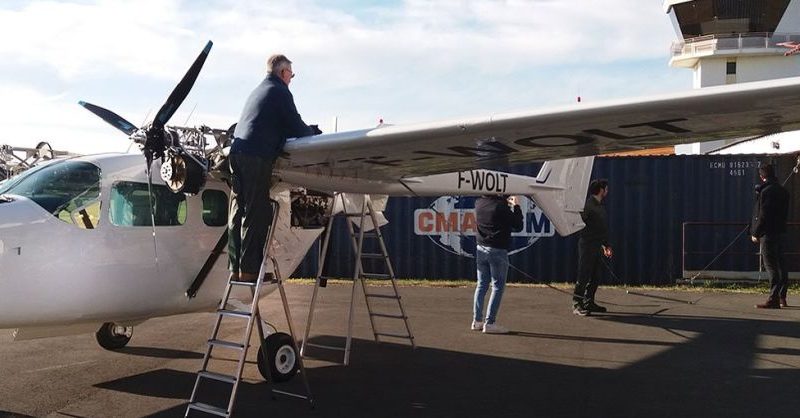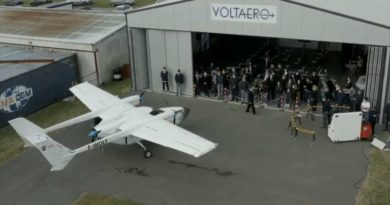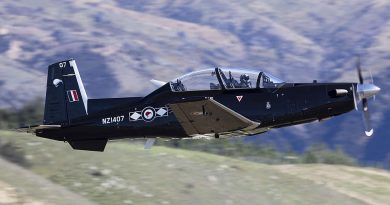VoltAero to cross english channel in its Cassino 1 aircraft.
Médis, France – The VoltAero team will perform its second historic crossing of the English Channel with an electric aircraft, using the company’s Cassio 1 demonstrator to fly between France and the United Kingdom for participation in the ACE21 Air Charter Expo and a visit to Cranfield University.
Cassio 1 is to traverse the Channel on September 13, departing from France’s northern port city of Calais and arriving at Cranfield Airport in the English county of Bedfordshire.
During its mid-day Cranfield stopover, Cassio 1 will be available for inspection by faculty and students at this renowned university. Briefings also will be provided by VoltAero and its KinectAir partner – which operates on-demand flight services driven by artificial intelligence and utilizing an advanced smartphone application.
Later the same day, Cassio 1 will fly to London Biggin Hill Airport for its September 14 display at the ACE21 Air Charter Expo, with VoltAero CEO & Chief Technology Officer Jean Botti taking part in the conference’s Green Charter 2021 panel discussion.
Cassio 1’s trip from France to the U.K. comes six years after the world’s first end-to-end English Channel crossing with an electric airplane, utilizing the E-Fan aircraft developed by VoltAero’s team in an Airbus-led program. The E-Fan’s batteries delivered 60 kilowatts of power for its two electric motors, while Cassio 1 utilizes VoltAero’s proprietary 600-kilowatt electric-hybrid power module. On E-Fan’s historic flight in July 2015, the aircraft took off from Lydd, England and landed at Calais, France.
VoltAero will repeat a history-making electric aviation crossing of the English Channel with its Cassio 1 demonstrator aircraft.
“Our second Channel crossing with an electric aircraft clearly shows how VoltAero’s team has progressed in advancing the Cassio program through its development phase for a planned certification in 2023,” explained Botti.
He added that both destinations for next week’s Cassio 1 trip are highly appropriate. “The stopover at Cranfield University will introduce Cassio to the next generation of engineers, program managers and decision-makers who are to lead the future of electric aviation,” he said. “And our participation in the ACE21 Air Charter Expo enables us to highlight how VoltAero’s family of Cassio aircraft will help redefine commercial air charter services and regional mobility.”
To date, the Cassio 1 demonstrator aircraft has flown more than 4,900 kilometers while validating VoltAero’s proprietary electric-hybrid power module, which combines electric motors with an internal combustion engine. In providing dual sources of energy, the electric-hybrid power module provides highly safe and efficient operations by using one source of power – electrical or mechanical, or both – depending on the flight scenario.
The module’s electric motors enable Cassio to perform nearly-silent takeoffs and landings, while the internal combustion engine serves as a range extender by recharging batteries once Cassio is airborne, as well as providing a secondary source of propulsion and for backup.
VoltAero’s first Cassio aircraft version to enter production will be the four-seat Cassio 330, with a combined electric-hybrid power of 330 kilowatts. Cassio 330 deliveries are targeted to begin in the second half of 2023, followed by the six-seat Cassio 480 and the 10-seat Cassio 600, utilizing electric-hybrid propulsion rated at 480 and 600 kilowatts, respectively.
The Cassio airplane family is designed for cruise speeds of 200 knots (360 km./hr.), with the airport take-off/landing distance targeted at less than 1,800 feet. At a planned availability of 10 hours per day, the aircraft will be able to perform up to eight rotations daily in charter and regional air service. Other applications for Cassio include pilot training, the transport of cargo and for medical airlift.
At full rate, VoltAero anticipates producing approximately 150 aircraft annually with all three members of the Cassio aircraft family. Rochefort Airport in the Nouvelle-Aquitaine region of France has been selected for the company’s final assembly facility, with its construction to begin before the end of 2021.
ENDS




